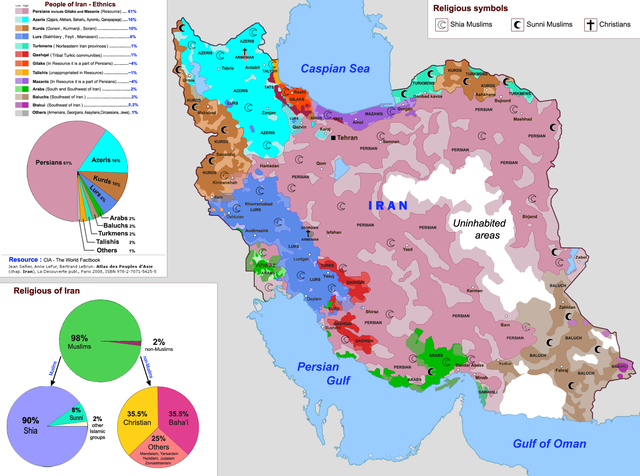GILAKS
Gilaks
:
Total
population : 3 to 4 million (2006)
Regions with significant populations : Provinces
of Gilan, Mazandaran, and Golestan in Iran
Languages : Gilaki
Religion : Mostly Shi'a Muslim
Related ethnic groups : Iranian peoples, Peoples
of the Caucasus
The
Gilak people or Gilaks are an Iranian ethnic group native to the
northern Iranian province of Gilan. They form one of the main ethnic
groups residing in the northern parts of Iran. Gilaks, along with
the closely related Mazandarani people, comprise part of the Caspian
people, who inhabit the southern and southwestern coastal regions
of the Caspian Sea.
They
speak the Gilaki language, an Iranian language which is closely
related to Mazandarani.
Economy
:
Gilaki people live both alongside the Alborz mountains, and in the
surrounding plains. Consequentially, those living along the northern
side of the Alborz mountains tend to raise livestock, while those
living in the plains farm. Gilaks play an important role in provincial
and national economy, supplying a large portion of the region's
agricultural staples, such as rice, grains, tobacco, and tea. Other
major industries include fishing and caviar exports, and the production
of silk. In addition to agricultural activities, Gilaks also control
other principal sectors of commerce of the province of Gilan such
as tourism, and share administrative and government positions with
civil servants from other regions of Iran.
People
:
The population of Gilaks is estimated to be between 3 and 4 million
(2006 estimation). They mainly live along the southwest coasts of
the Caspian Sea and are one of the main ethnic groups that reside
in the northern parts of Iran. The Gilaks are closely related to
the neighboring Mazandarani, and other groups of Caucasus descent,
such as Georgians, Armenians, and Azeris.
Language
:
The Gilaki language is a member of the Northwestern branch of the
Iranian languages. It is the main language spoken amongst the Gilaki
people, although various regional and local dialects of the Gilaki
language are common. Gilak people are fluent in both the Gilaki
language and standard Persian. Persian is the official language
of education in Iran, and since teachers are discouraged from using
regional dialects and accents in class, the Gilaki language is taught
to children at home.
The
Gilaki and Mazandarani languages (but not other Iranian languages)
share certain typological features with Caucasian languages. However,
with the growth of education and press, the differentiation between
Gilaki and other Iranian languages is likely to disappear. Gilaki
is closely related to Mazandarani and the two languages have similar
vocabularies. These two languages retain more than Persian does
of the noun declension system that was characteristic of older Iranian
languages.
Genetics
:
The Gilaks and their closely related Mazandarani occupy the South
Caspian region of Iran and speak languages belonging to the North-Western
branch of Iranian languages. It has been suggested that their ancestors
came from the Caucasus region, perhaps displacing an earlier group
in the South Caspian. Linguistic evidence supports this scenario,
in that the Gilaki and Mazandarani languages (but not other Iranian
languages) share certain typological features with Caucasian languages.
There have been patterns analyzed of mtDNA and Y chromosome variation
in the Gilaki and Mazandarani.
Based
on mtDNA HV1 sequences, the Gilaks and Mazandarani most closely
resemble their geographic and linguistic neighbors, namely other
Iranian groups. However, their Y chromosome types most closely resemble
those found in groups from the South Caucasus. A scenario that explains
these differences is a south Caucasian origin for the ancestors
of the Gilaki and Mazandarani, followed by introgression of women
(but not men) from local Iranian groups, possibly because of patrilocality.
Given that both mtDNA and language are maternally transmitted, the
incorporation of local Iranian women would have resulted in the
concomitant replacement of the ancestral Caucasian language and
mtDNA types of the Gilaki and Mazandarani with their current Iranian
language and mtDNA types. Concomitant replacement of language and
mtDNA may be a more general phenomenon than previously recognized.
The
Mazandarani and Gilaki groups fall inside a major cluster consisting
of populations from the Caucasus and West Asia and are particularly
close to the South Caucasus groups—Georgians, Armenians, and
Azerbaijanis. Iranians from Tehran and Isfahan are situated more
distantly from these groups.
Haplogroups
:
The Gilaks display a high frequency of Y-DNA haplogroups R1a1a,
J2a, J1, and G2a3b.
Assimilated
groups into the Gilak people :
In the Safavid, Afsharid, and Qajar era Gilan was settled by large
numbers of Georgians, Circassians, Armenians and other Peoples of
the Caucasus, whose descendants still live across Gilan.

Gilaks in Iran
Source
:
https://en.wikipedia.org/
wiki/Gilaks

